Zhe Sun
Parameter-Efficient Fine-Tuning of 3D DDPM for MRI Image Generation Using Tensor Networks
Jul 24, 2025Abstract:We address the challenge of parameter-efficient fine-tuning (PEFT) for three-dimensional (3D) U-Net-based denoising diffusion probabilistic models (DDPMs) in magnetic resonance imaging (MRI) image generation. Despite its practical significance, research on parameter-efficient representations of 3D convolution operations remains limited. To bridge this gap, we propose Tensor Volumetric Operator (TenVOO), a novel PEFT method specifically designed for fine-tuning DDPMs with 3D convolutional backbones. Leveraging tensor network modeling, TenVOO represents 3D convolution kernels with lower-dimensional tensors, effectively capturing complex spatial dependencies during fine-tuning with few parameters. We evaluate TenVOO on three downstream brain MRI datasets-ADNI, PPMI, and BraTS2021-by fine-tuning a DDPM pretrained on 59,830 T1-weighted brain MRI scans from the UK Biobank. Our results demonstrate that TenVOO achieves state-of-the-art performance in multi-scale structural similarity index measure (MS-SSIM), outperforming existing approaches in capturing spatial dependencies while requiring only 0.3% of the trainable parameters of the original model. Our code is available at: https://github.com/xiaovhua/tenvoo
Learning Long Short-Term Intention within Human Daily Behaviors
Apr 10, 2025Abstract:In the domain of autonomous household robots, it is of utmost importance for robots to understand human behaviors and provide appropriate services. This requires the robots to possess the capability to analyze complex human behaviors and predict the true intentions of humans. Traditionally, humans are perceived as flawless, with their decisions acting as the standards that robots should strive to align with. However, this raises a pertinent question: What if humans make mistakes? In this research, we present a unique task, termed "long short-term intention prediction". This task requires robots can predict the long-term intention of humans, which aligns with human values, and the short term intention of humans, which reflects the immediate action intention. Meanwhile, the robots need to detect the potential non-consistency between the short-term and long-term intentions, and provide necessary warnings and suggestions. To facilitate this task, we propose a long short-term intention model to represent the complex intention states, and build a dataset to train this intention model. Then we propose a two-stage method to integrate the intention model for robots: i) predicting human intentions of both value-based long-term intentions and action-based short-term intentions; and 2) analyzing the consistency between the long-term and short-term intentions. Experimental results indicate that the proposed long short-term intention model can assist robots in comprehending human behavioral patterns over both long-term and short-term durations, which helps determine the consistency between long-term and short-term intentions of humans.
Body Discovery of Embodied AI
Mar 25, 2025Abstract:In the pursuit of realizing artificial general intelligence (AGI), the importance of embodied artificial intelligence (AI) becomes increasingly apparent. Following this trend, research integrating robots with AGI has become prominent. As various kinds of embodiments have been designed, adaptability to diverse embodiments will become important to AGI. We introduce a new challenge, termed "Body Discovery of Embodied AI", focusing on tasks of recognizing embodiments and summarizing neural signal functionality. The challenge encompasses the precise definition of an AI body and the intricate task of identifying embodiments in dynamic environments, where conventional approaches often prove inadequate. To address these challenges, we apply causal inference method and evaluate it by developing a simulator tailored for testing algorithms with virtual environments. Finally, we validate the efficacy of our algorithms through empirical testing, demonstrating their robust performance in various scenarios based on virtual environments.
Bidirectional Prototype-Reward co-Evolution for Test-Time Adaptation of Vision-Language Models
Mar 12, 2025Abstract:Test-time adaptation (TTA) is crucial in maintaining Vision-Language Models (VLMs) performance when facing real-world distribution shifts, particularly when the source data or target labels are inaccessible. Existing TTA methods rely on CLIP's output probability distribution for feature evaluation, which can introduce biases under domain shifts. This misalignment may cause features to be misclassified due to text priors or incorrect textual associations. To address these limitations, we propose Bidirectional Prototype-Reward co-Evolution (BPRE), a novel TTA framework for VLMs that integrates feature quality assessment with prototype evolution through a synergistic feedback loop. BPRE first employs a Multi-Dimensional Quality-Aware Reward Module to evaluate feature quality and guide prototype refinement precisely. The continuous refinement of prototype quality through Prototype-Reward Interactive Evolution will subsequently enhance the computation of more robust Multi-Dimensional Quality-Aware Reward Scores. Through the bidirectional interaction, the precision of rewards and the evolution of prototypes mutually reinforce each other, forming a self-evolving cycle. Extensive experiments are conducted across 15 diverse recognition datasets encompassing natural distribution shifts and cross-dataset generalization scenarios. Results demonstrate that BPRE consistently achieves superior average performance compared to state-of-the-art methods across different model architectures, such as ResNet-50 and ViT-B/16. By emphasizing comprehensive feature evaluation and bidirectional knowledge refinement, BPRE advances VLM generalization capabilities, offering a new perspective on TTA.
VQ-Flow: Taming Normalizing Flows for Multi-Class Anomaly Detection via Hierarchical Vector Quantization
Sep 02, 2024

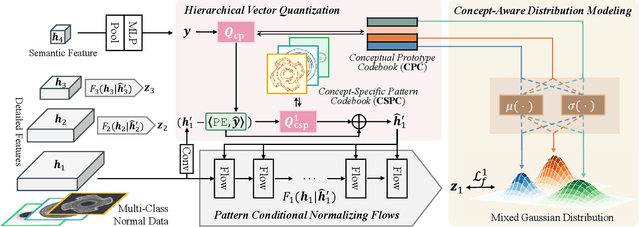

Abstract:Normalizing flows, a category of probabilistic models famed for their capabilities in modeling complex data distributions, have exhibited remarkable efficacy in unsupervised anomaly detection. This paper explores the potential of normalizing flows in multi-class anomaly detection, wherein the normal data is compounded with multiple classes without providing class labels. Through the integration of vector quantization (VQ), we empower the flow models to distinguish different concepts of multi-class normal data in an unsupervised manner, resulting in a novel flow-based unified method, named VQ-Flow. Specifically, our VQ-Flow leverages hierarchical vector quantization to estimate two relative codebooks: a Conceptual Prototype Codebook (CPC) for concept distinction and its concomitant Concept-Specific Pattern Codebook (CSPC) to capture concept-specific normal patterns. The flow models in VQ-Flow are conditioned on the concept-specific patterns captured in CSPC, capable of modeling specific normal patterns associated with different concepts. Moreover, CPC further enables our VQ-Flow for concept-aware distribution modeling, faithfully mimicking the intricate multi-class normal distribution through a mixed Gaussian distribution reparametrized on the conceptual prototypes. Through the introduction of vector quantization, the proposed VQ-Flow advances the state-of-the-art in multi-class anomaly detection within a unified training scheme, yielding the Det./Loc. AUROC of 99.5%/98.3% on MVTec AD. The codebase is publicly available at https://github.com/cool-xuan/vqflow.
ComKD-CLIP: Comprehensive Knowledge Distillation for Contrastive Language-Image Pre-traning Model
Aug 08, 2024Abstract:Contrastive Language-Image Pre-training (CLIP) excels in integrating semantic information between images and text through contrastive learning techniques. It has achieved remarkable performance in various multimodal tasks. However, the deployment of large CLIP models is hindered in resource-limited environments, while smaller models frequently fall short of meeting performance benchmarks necessary for practical applications. In this paper, we propose a novel approach, coined as ComKD-CLIP: Comprehensive Knowledge Distillation for Contrastive Language-Image Pre-traning Model, which aims to comprehensively distill the knowledge from a large teacher CLIP model into a smaller student model, ensuring comparable performance with significantly reduced parameters. ComKD-CLIP is composed of two key mechanisms: Image Feature Alignment (IFAlign) and Educational Attention (EduAttention). IFAlign makes the image features extracted by the student model closely match those extracted by the teacher model, enabling the student to learn teacher's knowledge of extracting image features. EduAttention explores the cross-relationships between text features extracted by the teacher model and image features extracted by the student model, enabling the student model to learn how the teacher model integrates text-image features. In addition, ComKD-CLIP can refine the knowledge distilled from IFAlign and EduAttention leveraging the results of text-image feature fusion by the teacher model, ensuring student model accurately absorbs the knowledge of teacher model. Extensive experiments conducted on 11 datasets have demonstrated the superiority of the proposed method.
SentenceVAE: Enable Next-sentence Prediction for Large Language Models with Faster Speed, Higher Accuracy and Longer Context
Aug 07, 2024Abstract:Current large language models (LLMs) primarily utilize next-token prediction method for inference, which significantly impedes their processing speed. In this paper, we introduce a novel inference methodology termed next-sentence prediction, aimed at enhancing the inference efficiency of LLMs. We present Sentence Variational Autoencoder (SentenceVAE), a tiny model consisting of a Sentence Encoder and a Sentence Decoder. The Sentence Encoder can effectively condense the information within a sentence into a singular token, while the Sentence Decoder can reconstruct this compressed token back into sentence. By integrating SentenceVAE into the input and output layers of LLMs, we develop Sentence-level LLMs (SLLMs) that employ a sentence-by-sentence inference method. In addition, the SentenceVAE module of SLLMS can maintain the integrity of the original semantic content by segmenting the context into sentences, thereby improving accuracy while boosting inference speed. Moreover, compared to previous LLMs, SLLMs process fewer tokens over equivalent context length, significantly reducing memory demands for self-attention computation and facilitating the handling of longer context. Extensive experiments on Wanjuan dataset have reveal that the proposed method can accelerate inference speed by 204~365%, reduce perplexity (PPL) to 46~75% of its original metric, and decrease memory overhead by 86~91% for the equivalent context length, compared to the token-by-token method.
Static and multivariate-temporal attentive fusion transformer for readmission risk prediction
Jul 15, 2024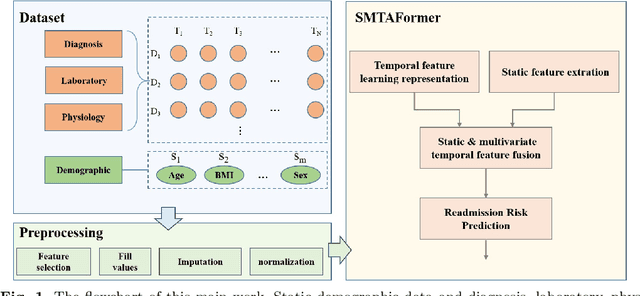
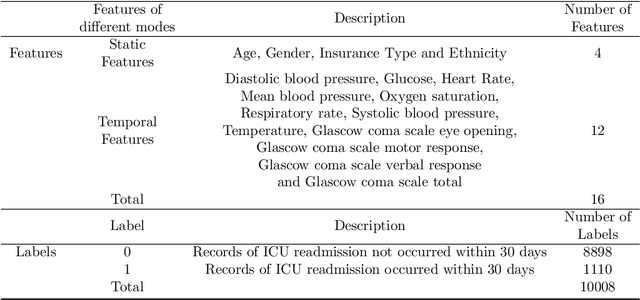
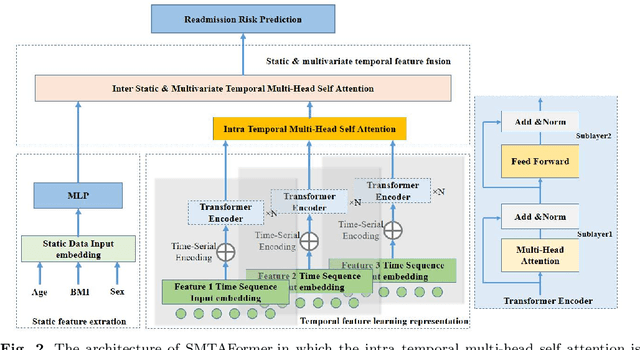

Abstract:Background: Accurate short-term readmission prediction of ICU patients is significant in improving the efficiency of resource assignment by assisting physicians in making discharge decisions. Clinically, both individual static static and multivariate temporal data collected from ICU monitors play critical roles in short-term readmission prediction. Informative static and multivariate temporal feature representation capturing and fusion present challenges for accurate readmission prediction. Methods:We propose a novel static and multivariate-temporal attentive fusion transformer (SMTAFormer) to predict short-term readmission of ICU patients by fully leveraging the potential of demographic and dynamic temporal data. In SMTAFormer, we first apply an MLP network and a temporal transformer network to learn useful static and temporal feature representations, respectively. Then, the well-designed static and multivariate temporal feature fusion module is applied to fuse static and temporal feature representations by modeling intra-correlation among multivariate temporal features and constructing inter-correlation between static and multivariate temporal features. Results: We construct a readmission risk assessment (RRA) dataset based on the MIMIC-III dataset. The extensive experiments show that SMTAFormer outperforms advanced methods, in which the accuracy of our proposed method is up to 86.6%, and the area under the receiver operating characteristic curve (AUC) is up to 0.717. Conclusion: Our proposed SMTAFormer can efficiently capture and fuse static and multivariate temporal feature representations. The results show that SMTAFormer significantly improves the short-term readmission prediction performance of ICU patients through comparisons to strong baselines.
CREST: Cross-modal Resonance through Evidential Deep Learning for Enhanced Zero-Shot Learning
Apr 15, 2024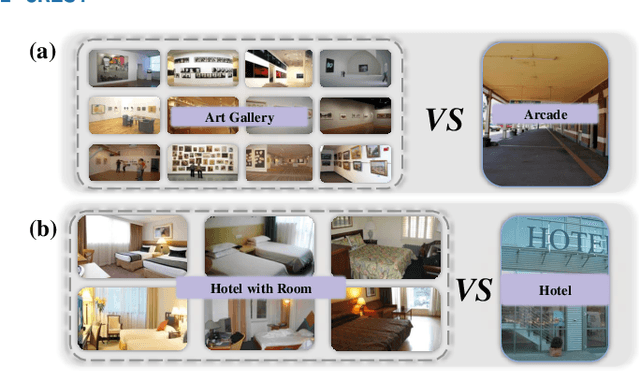



Abstract:Zero-shot learning (ZSL) enables the recognition of novel classes by leveraging semantic knowledge transfer from known to unknown categories. This knowledge, typically encapsulated in attribute descriptions, aids in identifying class-specific visual features, thus facilitating visual-semantic alignment and improving ZSL performance. However, real-world challenges such as distribution imbalances and attribute co-occurrence among instances often hinder the discernment of local variances in images, a problem exacerbated by the scarcity of fine-grained, region-specific attribute annotations. Moreover, the variability in visual presentation within categories can also skew attribute-category associations. In response, we propose a bidirectional cross-modal ZSL approach CREST. It begins by extracting representations for attribute and visual localization and employs Evidential Deep Learning (EDL) to measure underlying epistemic uncertainty, thereby enhancing the model's resilience against hard negatives. CREST incorporates dual learning pathways, focusing on both visual-category and attribute-category alignments, to ensure robust correlation between latent and observable spaces. Moreover, we introduce an uncertainty-informed cross-modal fusion technique to refine visual-attribute inference. Extensive experiments demonstrate our model's effectiveness and unique explainability across multiple datasets. Our code and data are available at: Comments: Ongoing work; 10 pages, 2 Tables, 9 Figures; Repo is available at https://github.com/JethroJames/CREST.
StreakNet-Arch: An Anti-scattering Network-based Architecture for Underwater Carrier LiDAR-Radar Imaging
Apr 14, 2024Abstract:In this paper, we introduce StreakNet-Arch, a novel signal processing architecture designed for Underwater Carrier LiDAR-Radar (UCLR) imaging systems, to address the limitations in scatter suppression and real-time imaging. StreakNet-Arch formulates the signal processing as a real-time, end-to-end binary classification task, enabling real-time image acquisition. To achieve this, we leverage Self-Attention networks and propose a novel Double Branch Cross Attention (DBC-Attention) mechanism that surpasses the performance of traditional methods. Furthermore, we present a method for embedding streak-tube camera images into attention networks, effectively acting as a learned bandpass filter. To facilitate further research, we contribute a publicly available streak-tube camera image dataset. The dataset contains 2,695,168 real-world underwater 3D point cloud data. These advancements significantly improve UCLR capabilities, enhancing its performance and applicability in underwater imaging tasks. The source code and dataset can be found at https://github.com/BestAnHongjun/StreakNet .
 Add to Chrome
Add to Chrome Add to Firefox
Add to Firefox Add to Edge
Add to Edge